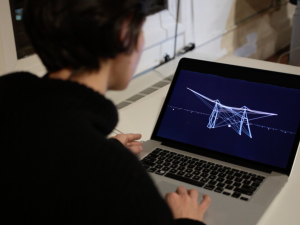Lisa M Jamhoury
Today's information-centered internet is a place where the mind often goes, but the body cannot follow. Recent advances in motion capture and browser technology, however, are paving the way for the body to come online. Using live skeletal data and volumetric video, Facing You envisions what an experiential internet could look and feel like.
http://lisajamhoury.com/portfolio/facing-you/
Description
In “The Untold Story of Magic Leap,” Kevin Kelly, founding executive editor of Wired, foretells the next evolution of the internet. He describes today’s internet of information, which “contains 60 trillion web pages, remembers 4 zettabytes of data, transmits millions of emails per second, all interconnected by sextillions of transistors,” and envisages the upcoming “internet of experiences,” of which today’s artificial, mixed and virtual realities are the seedlings. The current data-driven internet is the result of historical limitations in bandwidth, graphics processing and input devices—like webcams and keyboards—which have made the internet a place where the mind can go, but the body cannot follow. Recent advances in motion capture devices, graphics processing, bandwidth and browsers, however, are paving the way for the body to find its place online.
“Facing You” envisions what the experiential internet could look and feel like by bringing the body online in realtime. This interactive installation allows two people in two different places to physically meet and interact in virtual space. Both users are represented with full-body skeletal and volumetric data on a website. They can create effects in their shared environment with different interactions, like touching hands, touching feet or sharing the same virtual space. The experience runs entirely in the browser, and an online audience can tune in from other locations.
“Facing You” is built on an experimental open source software called Kinectron, which allows artists and activists to explore the power of bringing the body online. Kinectron is a desktop application and Javascript library that broadcasts images, volumetric and skeletal data from the Microsoft Kinect—a lightweight and inexpensive motion capture camera—to the web. This tool uses the same underlying networking technology as today’s video calling systems, allowing users to broadcast Kinect data from anywhere in the world, and to receive one or more broadcasts in a modern browser.
Classes
Thesis
